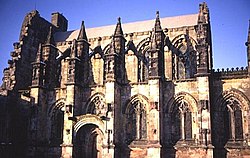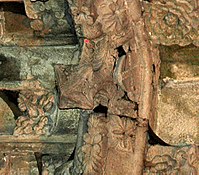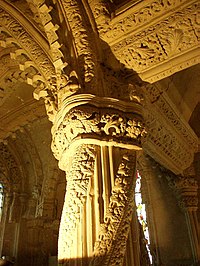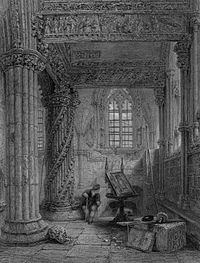Rosslyn Chapel
| Rosslyn Chapel | |
|
Roslin, Midlothian | |
|---|---|
 Rosslyn Chapel | |
| Scottish Episcopal Church | |
| Location | |
| Grid reference: | NT275630 |
| Location: | 55.85528 -3.16028 |
| History | |
| Information | |
| Website: | rosslynchapel.org.uk |
Rosslyn Chapel, formally known as the Collegiate Chapel of St Matthew, is a 15th-century chapel located at the village of Roslin in Midlothian.
Rosslyn Chapel stands on a small hill above Roslin Glen. It was founded in the mid-15th century by William Sinclair, 1st Earl of Caithness, as a collegiate church, with between four and six ordained canons and two boy choristers. Rosslyn Chapel is the third Sinclair place of worship at Roslin, the first being in Roslin Castle and the second (whose crumbling buttresses can still be seen today) in what is now Roslin Cemetery.[1]
The purpose of the college was to celebrate the Divine Office throughout the day and night and also to celebrate Holy Mass for all the faithful departed, including the deceased members of the Sinclair family. During this period the rich heritage of plainsong (a single melodic line) or polyphony (vocal harmony) would be used to enrich the singing of the liturgy. An endowment was made that would pay for the upkeep of the priests and choristers in perpetuity and they also had parochial responsibilities.
After the Reformation, in 1560, Roman worship in the chapel was brought to an end, although the Sinclair family continued to be Roman Catholics until the early 18th century. From that time the chapel was closed to public worship until 1861, when it was opened again as a place of worship according to the rites of the Scottish Episcopal Church.
Since the late 1980s, the chapel has also featured in speculative theories concerning a connection with the Knights Templar, and the Holy Grail. It was prominently featured in the 2003 bestseller novel The Da Vinci Code and its 2006 film adaptation: this connection brings a great number of visitors.
Rosslyn Chapel remains privately owned. The current owner is Peter St Clair-Erskine, 7th Earl of Rosslyn.[2]
Contents
Architecture
The original plans for Rosslyn have never been found or recorded, so it is open to speculation whether or not the chapel was intended to be built in its current layout. Its architecture is considered to be among the finest north of the Tyne.[3]
Construction of the chapel began on 20 September 1456, although it has often been recorded as 1446. The confusion over the building date comes from the chapel's receiving its founding charter to build a collegiate chapel in 1446 from Rome. Sinclair did not start to build the chapel until he had built houses for his craftsmen.
Although the original building was to be cruciform in shape, it was never completed. Only the choir was constructed, with the retro-chapel, otherwise called the Lady chapel, built on the much earlier crypt (Lower Chapel) believed to form part of an earlier castle. The foundations of the unbuilt nave and transepts stretching to a distance of 90 feet were recorded in the 19th century. The decorative carving was executed over a forty-year period. After the founder's death, construction of the planned nave and transepts was abandoned - either from lack of funds, lack of interest or a change in liturgical fashion.
The Lower Chapel (also known as the crypt or sacristy) should not be confused with the burial vaults that lie underneath Rosslyn Chapel.[1]
The chapel stands on fourteen pillars, which form an arcade of twelve pointed arches on three sides of the nave. At the east end, a fourteenth pillar between the penultimate pair form a three-pillared division between the nave and the Lady chapel.[4] The three pillars at the east end of the chapel are named, from north to south: the Master Pillar, the Journeyman Pillar, and most famously, the Apprentice Pillar. These names for the pillars date from the late Georgian period, until this time they were called The Earl's Pillar, The Shekinah and the Prince's pillar.
Apprentice pillar
The "Apprentice Pillar", or "Prentice Pillar", gets its name from a legend dating from the 18th century, involving the master mason in charge of the stonework in the chapel and his young apprentice mason. According to the legend, the master mason did not believe that the apprentice could perform the complicated task of carving the column without seeing the original which formed the inspiration for the design.
The master mason travelled to see the original himself, but upon his return was enraged to find that the upstart apprentice had completed the column by himself. In a fit of jealous anger, the master mason took his mallet and struck the apprentice on the head, killing him. The legend concludes that as punishment for his crime, the master mason's face was carved into the opposite corner to forever gaze upon his apprentice's pillar.[5]
The pillar is also referred to as the "Prince's Pillar" in An Account of the Chapel of Roslin (1778).[6]
On the architrave joining the pillar there is an inscription, Forte est vinum fortior est rex fortiores sunt mulieres super omnia vincit veritas: "Wine is strong, a king is stronger, women are stronger still, but truth conquers all" (taken from the apocryphal book 1 Esdras, chapters 3 & 4).
The apprentice legend is not the wildest of the stories attached to this piece of masonry. The conspiracy writer Henning Klovekorn proposed that the pillar is representative of one of the roots of the Yggdrasil tree of Norse mythology.[7] The fine carving is certainly such as will attract stories and fancies, though the French architect Eugène Viollet-le-Duc compared the general form of the pillar has been related to a type described by as a "bunch of sausages."[8]
Carvings
Among Rosslyn's many intricate carvings are a sequence of 213 cubes or 'boxes' protruding from pillars and arches with a selection of patterns on them. It is unknown if these patterns have any particular meaning attached to them. Many people have attempted to find information coded into them, but no interpretation has yet proven conclusive. Many of these 'boxes' are in fact not original, having been replaced in the 19th century after erosion damage.
There are more than 110 carvings of 'Green Men' in and around the chapel; carvings of human faces with greenery all around them, often growing out of their mouths. They are found in all areas of the chapel, with one example in the Lady Chapel, between the two middle altars of the east wall. The meaning of this common motif in churches is uncertain; it may represent mortality or perhaps resurrection.
Other carvings in the Rosslyn Chapel represent plants, including depictions of wheat, strawberries or lilies.[9] The wilder imaginations of the authors Robert Lomas and Christopher Knight, in keeping with the stories which have been wound around the chapel, suggested that some carvings in the chapel represent ears of maize, and on this based a claim that the Earl of Orkney sailed to the Americas long before Columbus.[10] (The actual resemblance of the carvings in question to wheat is far too pedestrian to base a book upon it.)
Crypt
The chapel has been a burial place for several generations of the Sinclairs; a crypt was once accessible from a descending stair at the rear of the chapel. This crypt has been sealed shut for many years, which may explain the recurrent legends that it is merely a front to a more extensive subterranean vault containing (variously) the mummified head of Jesus Christ,[11] the Holy Grail,[12] the treasure of the Knights Templar,[13] or the original crown jewels of Scotland.[14]
In 1837, when the 2nd Earl of Rosslyn died, his wish was to be buried in the original vault. Exhaustive searches over the period of a week were made, but no entrance to the original vault was found and he was buried beside his wife in the Lady Chapel.[15]
Rooftop pinnacle
The pinnacles on the rooftop have been subject to interest during renovation work in 2010. Nesting jackdaws had made the pinnacles unstable and as such had to be dismantled brick by brick revealing the existence of a chamber specifically made by the stonemasons to harbour bees. The hive, now abandoned, has been sent to local bee keepers to identify.[16]
Abandonment
In 1590, the Presbytery forbade George Ramsay, Minister of Lasswade, from burying the wife of Oliver St Clair in the chapel.
The same St Clair had been repeatedly asked to destroy the chapel's altars because they were taken to represent "monuments of idolatry". St Clair's tenants were forced to attend the Lasswade Parish Church. In 1592, St Clair, who had until then refused to destroy the altars, was summoned to appear before the Church of Scotland General Assembly and threatened with excommunication if the altars remained standing after the 17th August 1592. On the 31st August 1592, George Ramsay reported that the altars of Roslene were haille demolishit.[17]
After this, the chapel was abandoned, gradually falling into decay.
Restoration, conservation and tourism
In 1842 the chapel, now in a ruined and overgrown state, was visited by Queen Victoria, who expressed a desire that it should be preserved. Restoration work was carried out in 1862 by David Bryce on behalf of James Alexander, 3rd Earl of Rosslyn. The chapel was re-dedicated on 22 April 1862, and from this time, Sunday services were once again held, now under the jurisdiction of the Scottish Episcopal Church, for the first time in 270 years.
The Rosslyn Chapel Trust was established in 1995, with the purpose of overseeing its conservation and its opening as a sightseeing destination. The chapel underwent an extensive programme of conservation between 1997 and 2013. This included work to the roof, the stone, the carvings, the stained glass and the organ.[18] A steel canopy was erected over the chapel roof for fourteen years. This was to prevent further rain damage to the church and also to give it a chance to dry out properly. Three human skeletons were found during the restoration.[19] Major stonework repairs were completed by the end of 2011. The last major scaffolding was removed in August 2010.[20]
A new visitor centre opened in July 2011. The chapel's stained-glass windows and organ were fully restored. New lighting and heating were installed.[20] The expected cost of the restoration work is around £13 million, with about £3.7 million being spent on the Visitor Centre.
Photography and video have been forbidden in the chapel since 2008. The chapel sells commercially produced photos in its shop.[21] In 2006, historian Louise Yeoman criticised the Rosslyn Chapel trust for "cashing in" on the popularity of the The Da Vinci Code, against better knowledge.[22]
In the financial year of 2013-2014, Rosslyn Chapel recorded 144,823 visitors, the highest number since 2007-2008, when (at the height of popular interest induced by The Da Vinci Code), the number of visitors was close to 159,000.[23]
Popular myths and legends
The chapel became the subject of speculation regarding its supposed connection with the Knights Templar or Freemasonry beginning in the 1980s with the publication of a book named The Holy Blood and the Holy Grail (1982), followed by such as Born in Blood: The Lost Secrets of Freemasonry (1989), The Temple and the Lodge (1991), The Stone Puzzle of Rosslyn Chapel (2002) and their ilk. The theme promoted by these theories was based on the survival of the Knights Templar in Scotland long after their suppression elsewhere (conveniently sidestepping the point that the Templars were suppressed locally as everything south of the Forth was under English rule at the time). With the mediaeval legend of the Holy Grail thrown in, the books sold well and cemented the chapel's place in modern mythology.
The topic entered mainstream pop culture with Dan Brown's The Da Vinci Code (2003), reinforced by the subsequent film of the same name (2006). Numerous books were published after 2003 to cater to the popular interest in supposed connections between Rosslyn Chapel, Freemasonry, the Templars and the Holy Grail generated by Brown's novel.
The chapel was in fact built 150 years after the dissolution of the Knights Templar. Novelists claim it contains Templar symbols, such as the "Two riders on a single horse". Many generations after the Sinclairs built the chapel, William Sinclair of Roslin was involved in the creation of freemasonry in the eighteenth century, becoming the first Grand Master of the Grand Lodge of Scotland, which makes a rather tenuous link between Templars and masons.[24]
Robert L D Cooper, curator of the Grand Lodge of Scotland Museum and Library, in 2003 published a 12th edition of the 1892 Illustrated Guide to Rosslyn Chapel with the intention of countering the "nonsense published about Rosslyn Chapel over the last 15 years or so".[25] Cooper in 2006 also published Rosslyn Hoax? in which he actively debunks this type of speculation at length and in great detail. An example is the comparison of the Rosslyn myth of the Apprentice Pillar with that of the allegorical references to Hiram Abiff in Masonic ritual, and in the process he debunks any similarities between the two. A minute comparison between the Rosslyn Myth and the Masonic allegory can be found in a detailed tabular form in The Rosslyn Hoax?[26]
Cooper further debunks other claims of a connection between carvings within Rosslyn Chapel and Scottish Freemasonry. The suggestion that the Apprentice Pillar is a physical reference to the Entered Apprentice degree of Scottish Freemasonry logically led to the conclusion that the other two pillars (in line south to north with the so-called Apprentice Pillar) represented the Fellow of Craft degree (middle pillar) and the Master Mason's degree (north pillar). This association of three pillars in the east part of Rosslyn Chapel with the three degrees of Scottish Freemasonry is impossible, given the fact that (according to Cooper) the third degree of Freemasonry was invented c.1720 - almost 300 years after Rosslyn Chapel was founded.[27]
The claim that the layout of Rosslyn Chapel echoes that of Solomon's Temple[28] has been analysed by Mark Oxbrow and Ian Robertson in their book, Rosslyn and the Grail:
Rosslyn Chapel bears no more resemblance to Solomon's or Herod's Temple than a house brick does to a paperback book. If you superimpose the floor plans of Rosslyn Chapel and either Solomon's or Herod's Temple, you will actually find that they are not even remotely similar. Writers admit that the chapel is far smaller than either of the temples. They freely scale the plans up or down in an attempt to fit them together. What they actually find are no significant similarities at all. [...] If you superimpose the floor plans of Rosslyn Chapel and the East Quire of Glasgow Cathedral you will find a startling match: the four walls of both buildings fit precisely. The East Quire of Glasgow is larger than Rosslyn, but the designs of these two mediæval Scottish buildings are virtually identical. They both have the same number of windows and the same number of pillars in the same configuration. [...] The similarity between Rosslyn Chapel and Glasgow's East Quire is well established. Andrew Kemp noted that 'the entire plan of this Chapel corresponds to a large extent with the choir of Glasgow Cathedral' as far back as 1877 in the Proceedings of the Society of Antiquaries. Many alternative history writers are well aware of this but fail to mention it in their books.[9]
As to a possible connection between the St Clairs and the Knights Templar, the family testified against the Templars when that Order was put on trial in Edinburgh in 1309.[9] Historian Dr. Louise Yeoman, along with other mediæval scholars, says the Knights Templar connection is false, and points out that Rosslyn Chapel was built by William Sinclair so that Mass could be said for the souls of his family.[29]
It has also been claimed that other carvings in the chapel reflect Masonic imagery, such as the way that hands are placed in various figures. One carving may show a blindfolded man being led forward with a noose around his neck — similar to the way a candidate is prepared for initiation into Freemasonry. The carving has been eroded by time and pollution and is difficult to make out clearly. The chapel was built in the 15th century, and the earliest records of Freemasonic lodges date back only to the late 16th and early 17th centuries.[30] A more likely explanation however is that the Masonic imagery was added at a later date. This may have taken place in the 1860s when James St Clair-Erskine, 3rd Earl of Rosslyn instructed Edinburgh architect David Bryce, a known Freemason, to undertake restoration work on areas of the church including many of the carvings.[31]
Outside links
| ("Wikimedia Commons" has material about Rosslyn Chapel) |
- Official Rosslyn Chapel website
- Rosslyn Chapel's extraordinary carvings explained at last — an article on Rosslyn's Green Men, and an associated reading of its carvings, from The Scotsman
- QuickTime Virtual Reality Image of Rosslyn Chapel by Jonathan Greet, View 2
- "The Rosslyn Templar", a book about the pastel painting by R T McPherson in 1836 of a "Templar Knight at Roslin Chapel" with new photographs of the Chapel
References
- ↑ 1.0 1.1 Turnbull, Michael, 'Rosslyn Chapel Revealed' (Sutton Publishing Ltd., November 2007) ISBN 0-7509-4467-6 ISBN 978-0750944670
- ↑ "About Rosslyn Chapel". RosslynChapel.org.uk. http://www.rosslynchapel.org.uk/p/about-I1633. Retrieved 5 November 2014.
- ↑ Dunton, Larkin (1896). The World and Its People. Silver, Burdett. p. 66.
- ↑ Wallace-Murphy, Tim; Hopkins, Marilyn. Rosslyn: Guardians of the Secrets of the Holy Grail, p.8. Element Books, 1999 ISBN 1-86204-493-7.
- ↑ Dr Forbes, Bishop of Caithness, An Account of the Chapel of Rosslyn, 1774; cited in Rosslyn Chapel (1997) by the Earl of Rosslyn, page 27.
- ↑ Forbes , Robert An Account of the Chapel of Roslin. (reprint ed. Cooper, Robert L. D., Grand Lodge of Scotland, 2000. ISBN 0-902324-61-6)
- ↑ Klovekorn, Henning. The 99 Degrees of Freemasonry. Cornerstone, 2007 ISBN 1-887560-82-3.
- ↑ Finlay, Ian, Scottish Crafts, Harrap (1948), p.23, "On en voit un (pilier) composé de gros boudins en spirale dans l'église de Sainte-Croix de Provins," Viollet-le-Duc, Dictionnaire Raisonné de l’Architecture Française du XIe au XVIe siècle/Pilier
- ↑ 9.0 9.1 9.2 Oxbrow, Mark; Robertson, Ian (2005). Rosslyn and the Grail. Edinburgh: Mainstream Publishing. ISBN 1-84596-076-9.
- ↑ Knight, Christopher; Lomas, Robert. The Hiram Key. Fair Winds Press, 2001 ISBN 1-931412-75-8.
- ↑ Laidler, Keith, The Head of God – The Lost Treasure of the Templars (1998).
- ↑ Wallace-Murphy, Tim; Hopkins, Marilyn, Rosslyn: Guardian of Secrets of the Holy Grail (1999).
- ↑ Robert Lomas, The Origins of Freemasonry
- ↑ Ralls-MacLeod, Karen; Robertson, Ian, The Quest for the Celtic Key (2002).
- ↑ Donaldson's Guide to Rosslyn Chapel published 1862.
- ↑ "Rosslyn Chapel was haven for bees". BBC News. 30 March 2010. http://news.bbc.co.uk/2/hi/uk_news/scotland/8594724.stm. Retrieved 5 November 2011.
- ↑ John Charles Carrick, The Abbey of S. Mary, Newbottle: a memorial of the royal visit, 1907, G. Lewis & Co., 1908, p. 153.
- ↑ "The Chapel Today". rosslynchapel.org.uk. http://www.rosslynchapel.org.uk/p/the-chapel-today-I153/. Retrieved 5 November 2011.
- ↑ http://www.midlothianadvertiser.co.uk/news/local-headlines/rosslyn_chapel_bones_to_be_dated_1_2061151
- ↑ 20.0 20.1 "Rosslyn Chapel's resurrection revealed". The Scotsman. 12 August 2010. http://www.scotsman.com/news/rosslyn_chapel_s_resurrection_revealed_1_821022. Retrieved 5 November 2011.
- ↑ "Rosslyn Chapel - FAQs". http://www.rosslynchapel.org.uk/p/faqs-I80/. Retrieved 18 October 2012.
- ↑ "What really upsets me is that they know the Knights Templar connection is false, yet they still perpetuate the myth on their interpretation boards." "Historian attacks Rosslyn Chapel for 'cashing in on Da Vinci Code'". The Scotsman. 3 May 2006. http://www.scotsman.com/news/historian_attacks_rosslyn_chapel_for_cashing_in_on_da_vinci_code_1_1116376. Retrieved 8 May 2014.
- ↑ The trust's financial year ends on 31 March. Scaffolding coming down helps visitor numbers go up, Rosslyn Chapel Trust website (April 2014).
- ↑ National Geographic Channel. Knights Templar, 22 February 2006 video documentary, by Jesse Evans
- ↑ "Book Review" at the Grand Lodge of Scotland website: "There has been so much nonsense published about Rosslyn Chapel over the last 15 years or so that it is now extremely difficult to know what is nonsense and what is accurate."
- ↑ Robert L D Cooper, The Rosslyn Hoax?, Lewis Masonic 2006, pp.173-4
- ↑ Robert L D Cooper, The Rosslyn Hoax?, Lewis Masonic 2006, pp.146-7
- ↑ Burstein, Dan (2004). Secrets of the Code: The Unauthorized Guide to the Mysteries Behind the Da Vinci Code, p. 248. CDS Books. ISBN 1-59315-022-9.
- ↑ "Historian attacks Rosslyn Chapel for 'cashing in on Da Vinci Code'". The Scotsman. 3 May 2006. http://www.scotsman.com/news/historian_attacks_rosslyn_chapel_for_cashing_in_on_da_vinci_code_1_1116376. Retrieved 8 May 2014.
- ↑ History page from the website of the United Grand Lodge of England
- ↑ "The St Clair Family". rosslynchapel.org.uk. http://www.rosslynchapel.org.uk/p/the-st-clair-family-I178/. Retrieved 5 November 2011.
Books
- Cooper, Robert L. D. The Rosslyn Hoax?. Lewis Masonic. 2006. ISBN 0-85318-255-8.
- Forbes, Robert An Account of the Chapel of Roslin. (reprint ed. Cooper, Robert L. D., Grand Lodge of Scotland, 2000. ISBN 0-902324-61-6).
- Hay, Richard Augustin, Genealogie of the Sainteclaires of Rosslyn. 1835 (reprint ed. Robert L. D. Cooper, Grand Lodge of Scotland. 2002. ISBN 0-902324-63-2).
- Thompson, John, The Illustrated Guide to Rosslyn Chapel and Castle, Hawthornden &c., 1st ed. 1892 (12th edition, Robert L. D. Cooper (ed.), Masonic Publishing Co. 2003. ISBN 0-9544268-1-9).
- Peter St Clair-Erskine, 7th Earl of Rosslyn, Rosslyn Chapel, Rosslyn Chapel Trust, 1997





